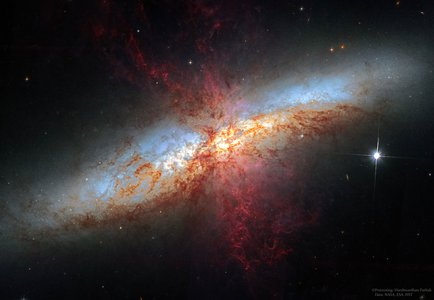Groundbreaking study unveils secrets of galactic outflows

Theoretical sketch for galactic winds. The distribution in the background (red) shows the gas outflows of galaxies detected by MUSE.
Credit: Guo et al. 2023, AIP
Under certain circumstances galaxies release huge quantities of matter into their environment, triggered by a large number of explosions of massive stars. The MUSE instrument of the Very Large Telescope of the European Southern Observatory (ESO) has now demonstrated for the first time that such “galactic winds” are by no means rare, but actually occur frequently.
An international research team, led by the Centre national de la recherche scientifique (CNRS), found the double-cone-shaped structures characteristic of galactic winds when examining a sample of around 100 galaxies. However, these are only visible in specific spectral lines of light and only if the sensitivity of the measurement is extremely high. Previously only very few such cases were known, most of which were discovered also with the MUSE instrument. Professor Lutz Wisotzki, head of the Galaxies and Quasars section at the Leibniz Institute for Astrophysics Potsdam (AIP) and co-author of the article in the science journal “Nature” says: “MUSE shows us that such galactic-wide outflows are present in almost every star-forming galaxy. In addition, the new results allow us to recognize exactly what size and shape these galactic winds typically have. Until now, this was only possible in very rare extreme cases.”
Galactic winds are observed in nearby galaxies, such as M82, which is called “Cigar Galaxy” because of its shape. Credit: NASA, ESA, Hubble; Processing & Copyright: Harshwardhan Pathak
Outflowing gas is thought to play a crucial role in the cosmic evolution of galaxies by regulating their growth and star formation. Theoretical calculations predict “bipolar” shapes for the outflows, which extend above and below the galactic plane far into the circumgalactic medium. Similar shapes have also been observed directly in some nearby galaxies, such as the “cigar galaxy” M82 and even in our own Milky Way, but there we can only see the innermost regions and cannot create an overall picture.
Cosmological simulations of galaxy formation predict for the young universe that the phenomenon of galactic winds occurred much more frequently and strongly during these early phases: Due to the higher star formation activity of young galaxies, there were more supernova explosions and thus stronger outflows. These transport gas and energy from a galaxy into its surroundings, thus depriving it of the necessary fuel for further star formation, while at the same time enriching its “circumgalactic” environment. This so-called feedback process is presumably a crucial element in our understanding of the formation and evolution of galaxies, but it has only been insufficiently constrained through observations due to the difficulty of detecting the phenomenon.
The new study with the MUSE instrument now shows directly that the galactic gas flows out into the surroundings of the galaxies, reaching distances of more than 30,000 light years. The observable signal depends strongly on the orientation of the galaxy relative to the line of sight: if the system is viewed from the side, there is strong emission above and below the plane of the galaxy, whereas for galaxies viewed from “above” or “below”, the signal is weaker and more evenly distributed. These observations impressively confirm the previously theoretically predicted bipolar form of the outflows perpendicular to the plane of the galaxy.
Wissenschaftliche Ansprechpartner:
Prof. Dr. Lutz Wisotzki, 0331 7499 532, lwisotzki@aip.de
Originalpublikation:
https://doi.org/10.1038/s41586-023-06718-w
Weitere Informationen:
Guo, Y., Bacon, R., Bouché, N.F. et al. Bipolar outflows out to 10 kpc for massive galaxies at redshift z ≈ 1. Nature 624, 53–56 (2023).
https://www.aip.de/en/news/groundbreaking-study-unveils-secrets-of-galactic-outflows/
Media Contact
All latest news from the category: Physics and Astronomy
This area deals with the fundamental laws and building blocks of nature and how they interact, the properties and the behavior of matter, and research into space and time and their structures.
innovations-report provides in-depth reports and articles on subjects such as astrophysics, laser technologies, nuclear, quantum, particle and solid-state physics, nanotechnologies, planetary research and findings (Mars, Venus) and developments related to the Hubble Telescope.
Newest articles

NASA: Mystery of life’s handedness deepens
The mystery of why life uses molecules with specific orientations has deepened with a NASA-funded discovery that RNA — a key molecule thought to have potentially held the instructions for…

What are the effects of historic lithium mining on water quality?
Study reveals low levels of common contaminants but high levels of other elements in waters associated with an abandoned lithium mine. Lithium ore and mining waste from a historic lithium…

Quantum-inspired design boosts efficiency of heat-to-electricity conversion
Rice engineers take unconventional route to improving thermophotovoltaic systems. Researchers at Rice University have found a new way to improve a key element of thermophotovoltaic (TPV) systems, which convert heat…




